Seasonal and Interannual Variability of the Indo-Pacific Warm Pool and its Associated Climate Factors Based on Remote Sensing
Abstract
1. Introduction
2. Materials and Methods
2.1. Data
2.2. Methods
3. Results
3.1. The SST Climatology and Trend of the Indo-Pacific Warm Pool
3.2. Multi-time scale Variabilities of the Indo-Pacific Warm Pool in Separated Demarcations
3.2.1. Seasonal Variabilities of the Indo-Pacific Warm Pool in Separated Demarcations
3.2.2. Interannual Variabilities of the Indo-Pacific Warm Pool in Separated Demarcations
3.3. The Relationships Between the Dominant Climate Indices and the Indo-Pacific Warm Pool
4. Discussion
5. Conclusions
Author Contributions
Funding
Acknowledgments
Conflicts of Interest
References
- Graham, N.E.; Barnett, T.P. Sea Surface Temperature, Surface Wind Divergence, and Convection over Tropical Oceans. Science 1987, 238, 657–659. [Google Scholar] [CrossRef]
- Yan, X.-H.; Ho, C.-R.; Zheng, Q.; Klemas, V. Temperature and Size Variabilities of the Western Pacific Warm Pool. Science 1992, 258, 1643–1645. [Google Scholar] [CrossRef]
- Cravatte, S.; Delcroix, T.; Zhang, D.; McPhaden, M.; Leloup, J. Observed freshening and warming of the western Pacific Warm Pool. Clim. Dyn. 2009, 33, 565–589. [Google Scholar] [CrossRef]
- Kim, S.T.; Yu, J.-Y.; Lu, M.-M. The distinct behaviors of Pacific and Indian Ocean warm pool properties on seasonal and interannual time scales. J. Geophys. Res.-Atmos. 2012, 117, D05128. [Google Scholar] [CrossRef]
- Moffa-Sanchez, P.; Rosenthal, Y.; Babila, T.L.; Mohtadi, M.; Zhang, X. Temperature Evolution of the Indo-Pacific Warm Pool Over the Holocene and the Last Deglaciation. Paleoceanogr. Paleoclimatol. 2019, 34, 1107–1123. [Google Scholar] [CrossRef]
- Williams, A.P.; Funk, C. A westward extension of the warm pool leads to a westward extension of the Walker circulation, drying eastern Africa. Clim. Dyn. 2011, 37, 2417–2435. [Google Scholar] [CrossRef]
- Ronghui, H.; Li, L. Numerical simulation of the relationship between the anomaly of subtropical high over East Asia and the convective activities in the western tropical Pacific. Adv. Atmos. Sci. 1989, 6, 202–214. [Google Scholar] [CrossRef]
- Huang, R.; Sun, F. Impacts of the Tropical Western Pacific on the East Asian Summer Monsoon. J. Meteorol. Soc. Jpn. Ser. II 1992, 70, 243–256. [Google Scholar] [CrossRef]
- Hu, Z.-Z. Interdecadal variability of summer climate over East Asia and its association with 500 hPa height and global sea surface temperature. J. Geophys. Res.-Atmos. 1997, 102, 19403–19412. [Google Scholar] [CrossRef]
- Webster, P.J.; Holland, G.J.; Curry, J.A.; Chang, H.-R. Changes in Tropical Cyclone Number, Duration, and Intensity in a Warming Environment. Science 2005, 309, 1844–1846. [Google Scholar] [CrossRef]
- Zhao, J.; Zhan, R.; Wang, Y.; Tao, L. Intensified Interannual Relationship between Tropical Cyclone Genesis Frequency over the Northwest Pacific and the SST Gradient between the Southwest Pacific and the Western Pacific Warm Pool since the Mid-1970s. J. Clim. 2016, 29, 3811–3830. [Google Scholar] [CrossRef]
- Wang, L.; Chen, G. Impact of the Spring SST Gradient between the Tropical Indian Ocean and Western Pacific on Landfalling Tropical Cyclone Frequency in China. Adv. Atmos. Sci. 2018, 35, 682–688. [Google Scholar] [CrossRef]
- Ho, C.R.; Zheng, Q.; Kuo, N.J.; Tsai, C.H.; Huang, N.E. Observation of the Kuroshio intrusion region in the South China Sea from AVHRR data. Int. J. Remote Sens. 2004, 25, 4583–4591. [Google Scholar] [CrossRef]
- Picaut, J.; Ioualalen, M.; Menkes, C.; Delcroix, T.; McPhaden, M.J. Mechanism of the Zonal Displacements of the Pacific Warm Pool: Implications for ENSO. Science 1996, 274, 1486–1489. [Google Scholar] [CrossRef]
- Weller, E.; Min, S.-K.; Cai, W.; Zwiers, F.W.; Kim, Y.-H.; Lee, D. Human-caused Indo-Pacific warm pool expansion. Science Advances 2016, 2, e1501719. [Google Scholar] [CrossRef] [PubMed]
- Robles-Tamayo, C.M.; Valdez-Holguín, J.E.; García-Morales, R.; Figueroa-Preciado, G.; Herrera-Cervantes, H.; López-Martínez, J.; Enríquez-Ocaña, L.F. Sea Surface Temperature (SST) Variability of the Eastern Coastal Zone of the Gulf of California. Remote Sens. 2018, 10, 1434. [Google Scholar] [CrossRef]
- Bosc, C.; Delcroix, T.; Maes, C. Barrier layer variability in the western Pacific warm pool from 2000 to 2007. J. Geophys. Res.-Oceans 2009, 114, C06023. [Google Scholar] [CrossRef]
- Lee, D.; Son, S.; Kim, W.; Park, J.M.; Joo, H.; Lee, S.H. Spatio-Temporal Variability of the Habitat Suitability Index for Chub Mackerel (Scomber Japonicus) in the East/Japan Sea and the South Sea of South Korea. Remote Sens. 2018, 10, 938. [Google Scholar] [CrossRef]
- Sun, D.-Z. A Possible Effect of an Increase in the Warm-Pool SST on the Magnitude of El Niño Warming. J. Clim. 2003, 16, 185–205. [Google Scholar] [CrossRef]
- Ho, C.-R.; Yan, X.-H.; Zheng, Q. Satellite Observations of Upper-Layer Variabilities in the Western Pacific Warm Pool. Bull. Amer. Meteorol. Soc. 1995, 76, 669–679. [Google Scholar] [CrossRef]
- Maes, C.; Sudre, J.; Garçon, V. Detection of the Eastern Edge of the Equatorial Pacific Warm Pool Using Satellite-Based Ocean Color Observations. SOLA 2010, 6, 129–132. [Google Scholar] [CrossRef][Green Version]
- Hu, S.; Hu, D. Heat center of the western Pacific warm pool. Chin. J. Oceanol. Limnol. 2012, 30, 169–176. [Google Scholar] [CrossRef]
- Zhou, G.; Yang, S.; Zheng, D. Multi-scale variation of the meridional movement of the western Pacific warm pool and its associated large-scale climate features. Theor. Appl. Climatol. 2017, 129, 859–872. [Google Scholar] [CrossRef]
- Ramanathan, V.; Collins, W. Thermodynamic regulation of ocean warming by cirrus clouds deduced from observations of the 1987 El Niño. Nature 1991, 351, 27–32. [Google Scholar] [CrossRef]
- Paris, M.L.; Subrahmanyam, B. Role of El Niño Southern Oscillation (ENSO) Events on Temperature and Salinity Variability in the Agulhas Leakage Region. Remote Sens. 2018, 10, 127. [Google Scholar] [CrossRef]
- Jia, F.; Hu, D.; Hu, S.; Feng, J. Niño4 as a Key Region for the Interannual Variability of the Western Pacific Warm Pool. J. Geophys. Res.-Oceans 2017, 122, 9299–9314. [Google Scholar] [CrossRef]
- Larkin, N.K.; Harrison, D.E. Global seasonal temperature and precipitation anomalies during El Niño autumn and winter. Geophys. Res. Lett. 2005, 32, L16705. [Google Scholar] [CrossRef]
- Chongyin, L.; Mingquan, M.; Guangqing, Z. The variation of warm pool in the equatorial western pacific and its impacts on climate. Adv. Atmos. Sci. 1999, 16, 378–394. [Google Scholar] [CrossRef]
- Clement, A.C.; Seager, R.; Murtugudde, R. Why Are There Tropical Warm Pools? J. Clim. 2005, 18, 5294–5311. [Google Scholar] [CrossRef]
- Zhang, W.; Li, H.; Jin, F.-F.; Stuecker, M.F.; Turner, A.G.; Klingaman, N.P. The Annual-Cycle Modulation of Meridional Asymmetry in ENSO’s Atmospheric Response and Its Dependence on ENSO Zonal Structure. J. Clim. 2015, 28, 5795–5812. [Google Scholar] [CrossRef]
- Saji, N.H.; Goswami, B.N.; Vinayachandran, P.N.; Yamagata, T. A dipole mode in the tropical Indian Ocean. Nature 1999, 401, 360–363. [Google Scholar] [CrossRef] [PubMed]
- Locarnini, R.A.; Mishonov, A.V.; Antonov, J.I.; Boyer, T.P.; Garcia, H.E.; Baranova, O.K.; Zweng, M.M.; Paver, C.R.; Reagan, J.R.; Johnson, D.R.; et al. World Ocean Atlas 2013 Volume 1: Temperature; Levitus, S., Technical, A.M., Eds.; NOAA Atlas NESDIS 73; US Government Printing Office: Washington, DC, USA, 2013; p. 40. [CrossRef]
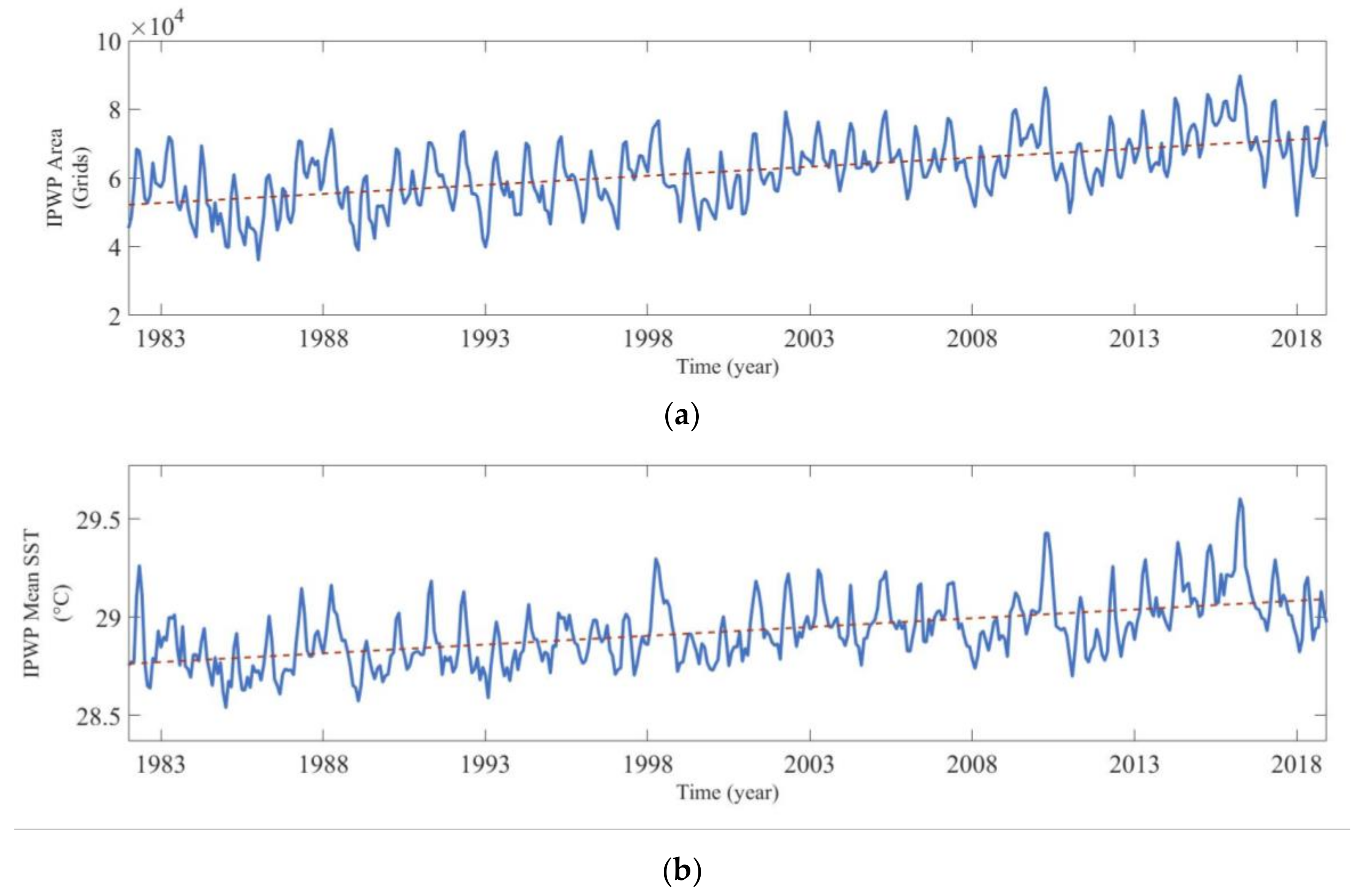
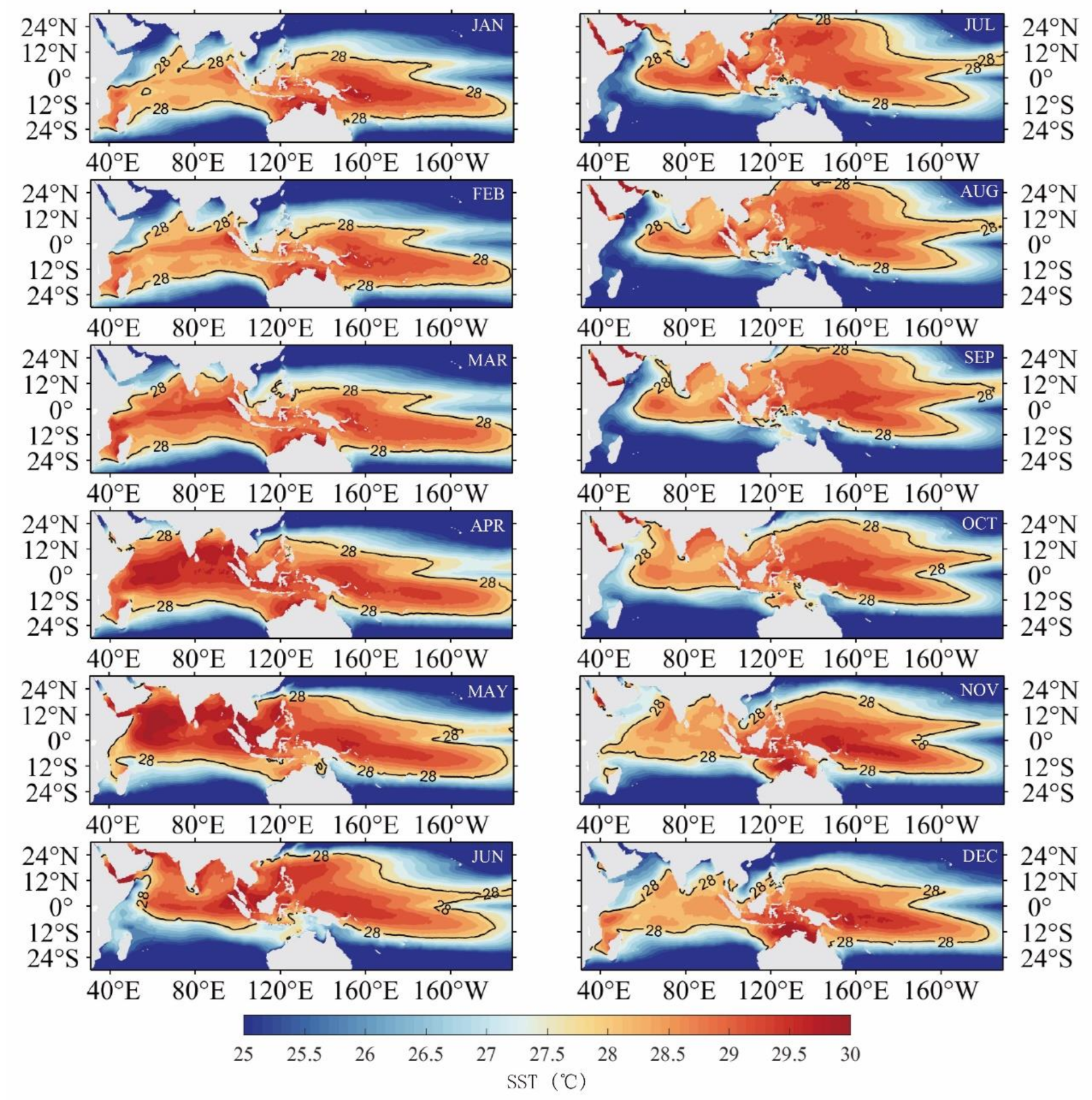
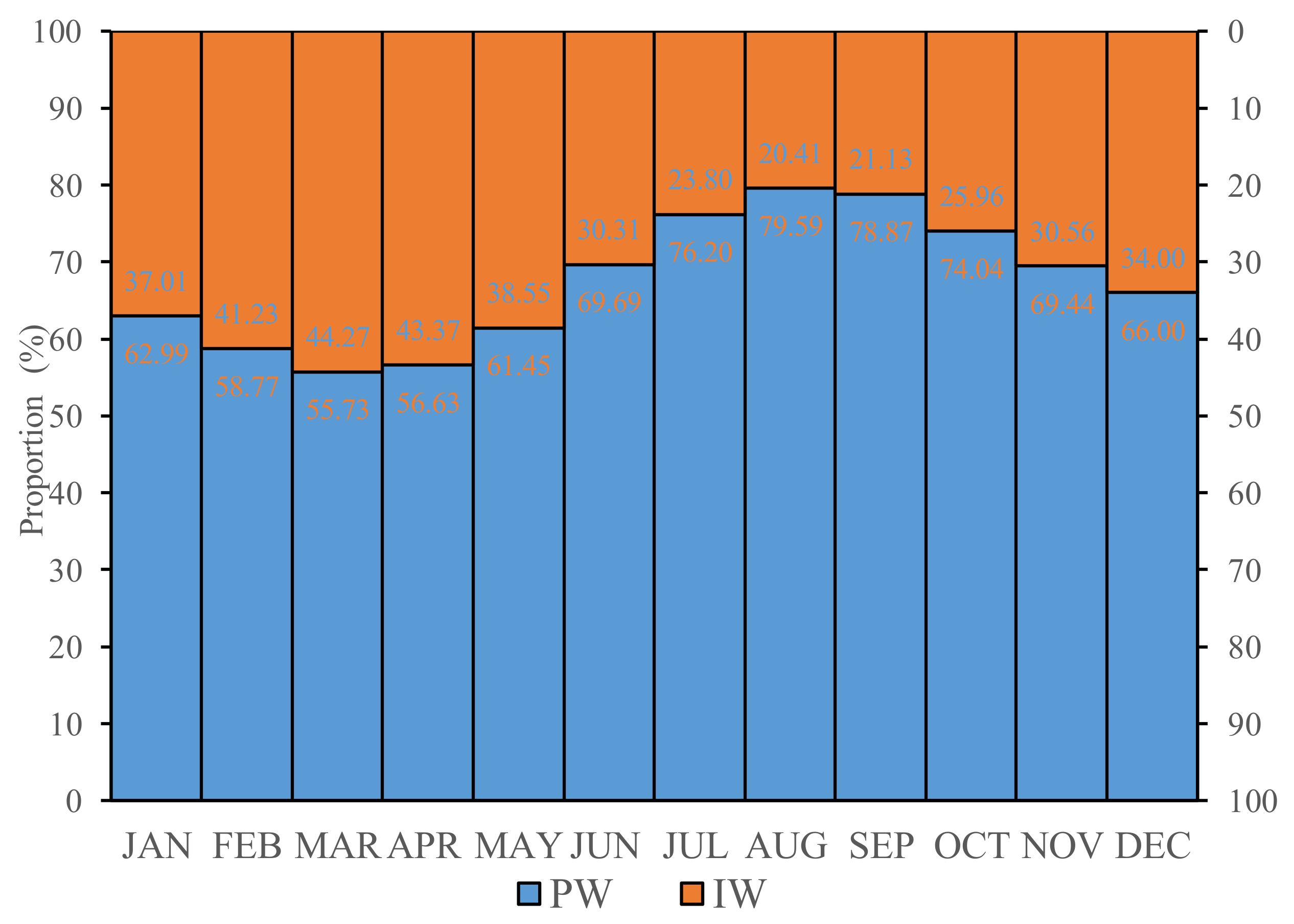
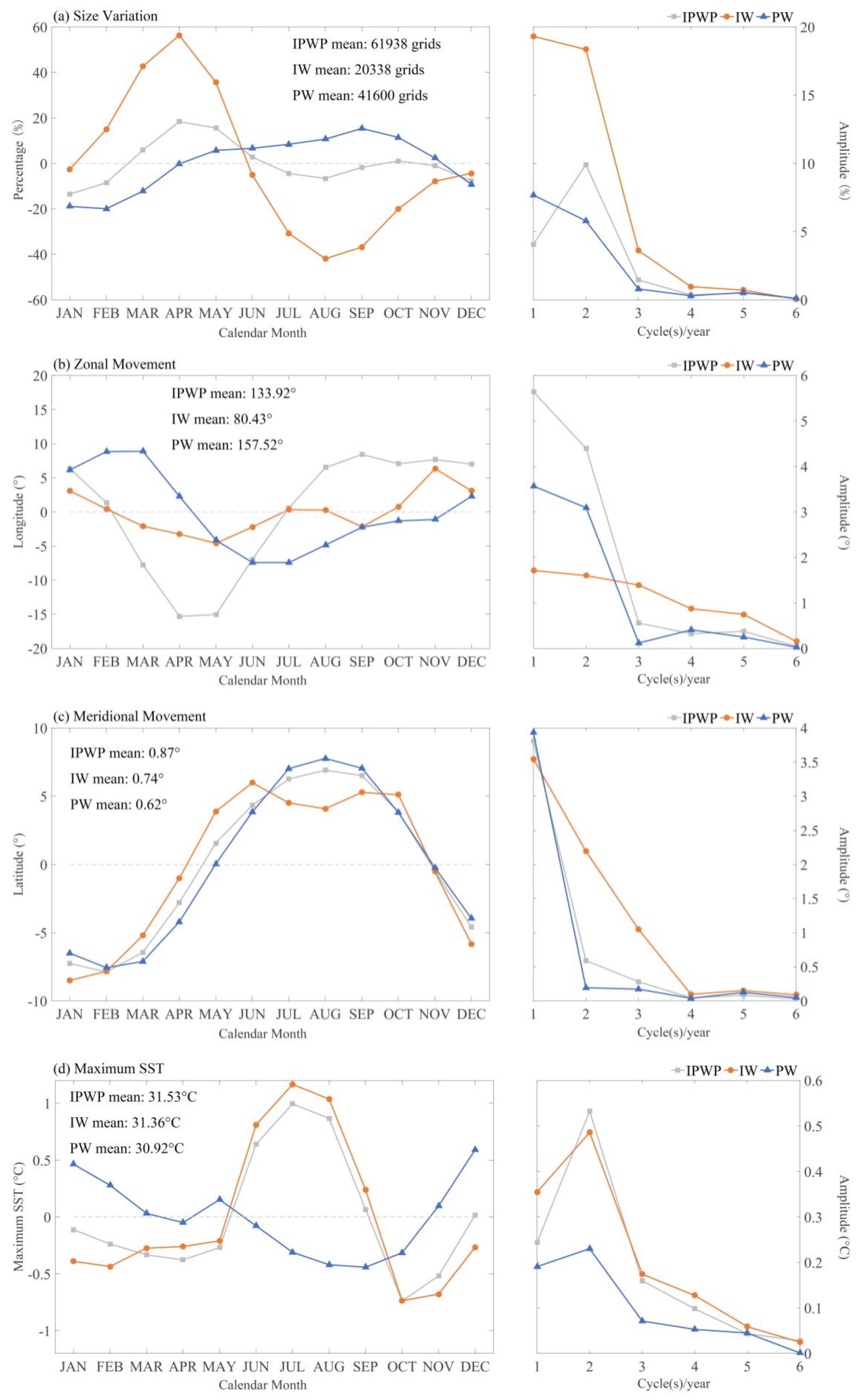
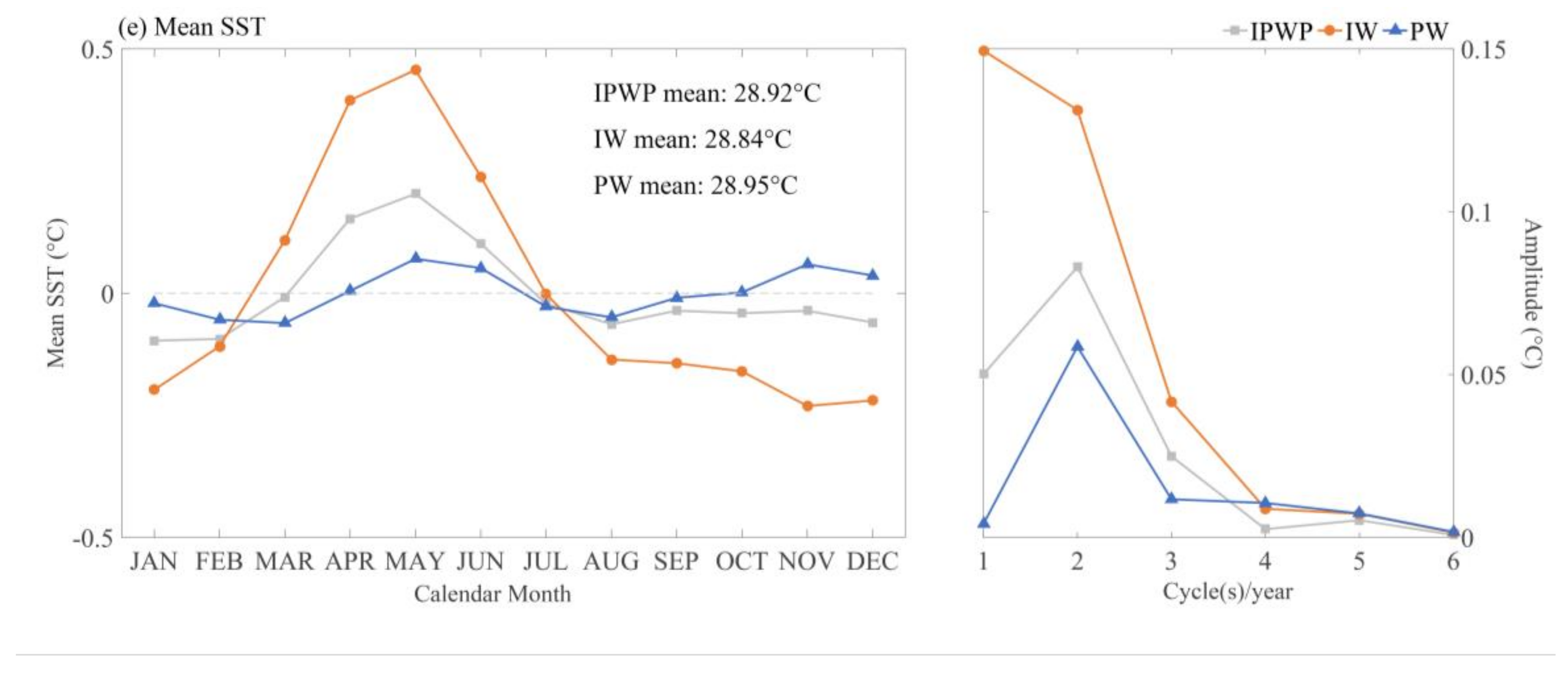
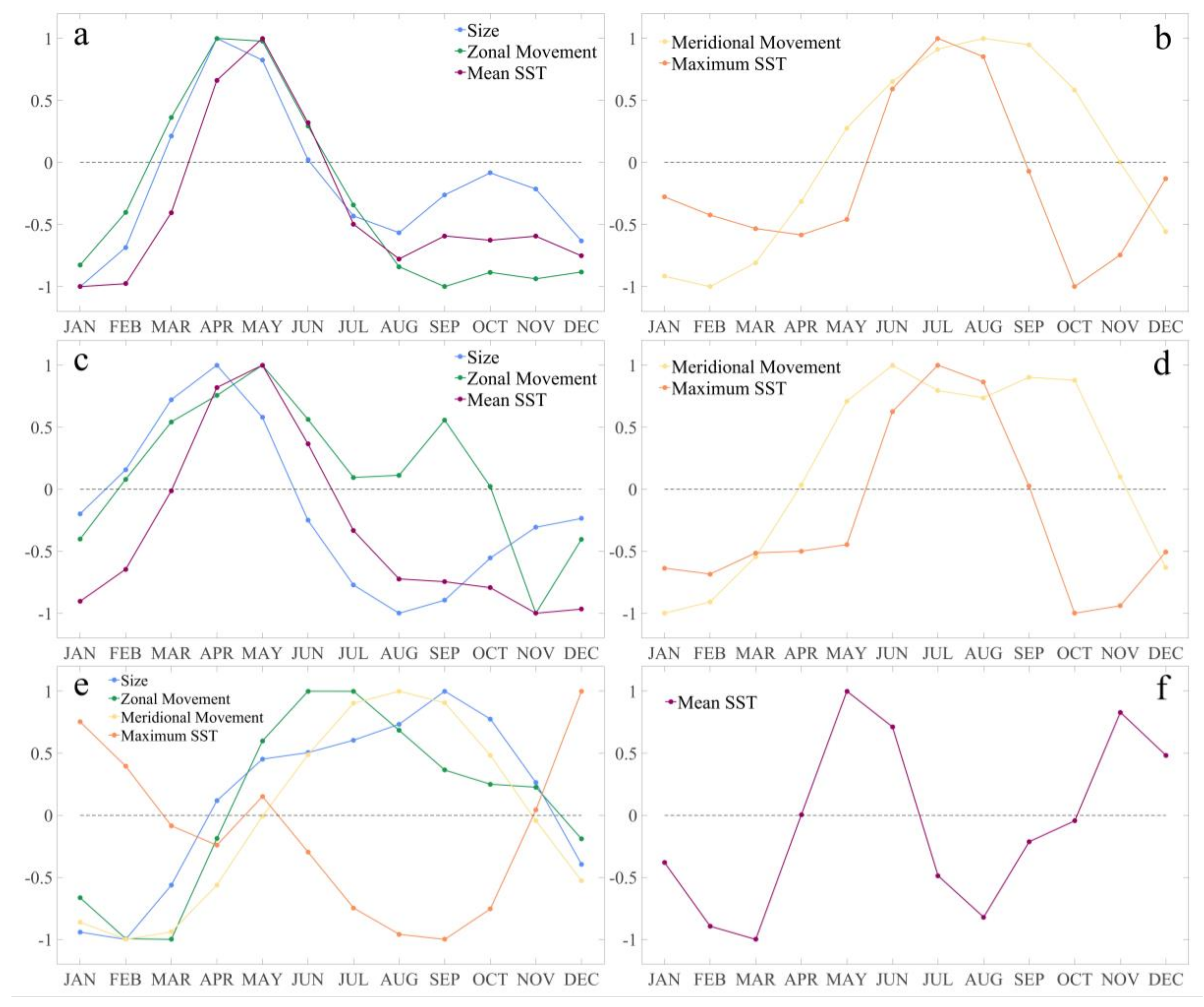
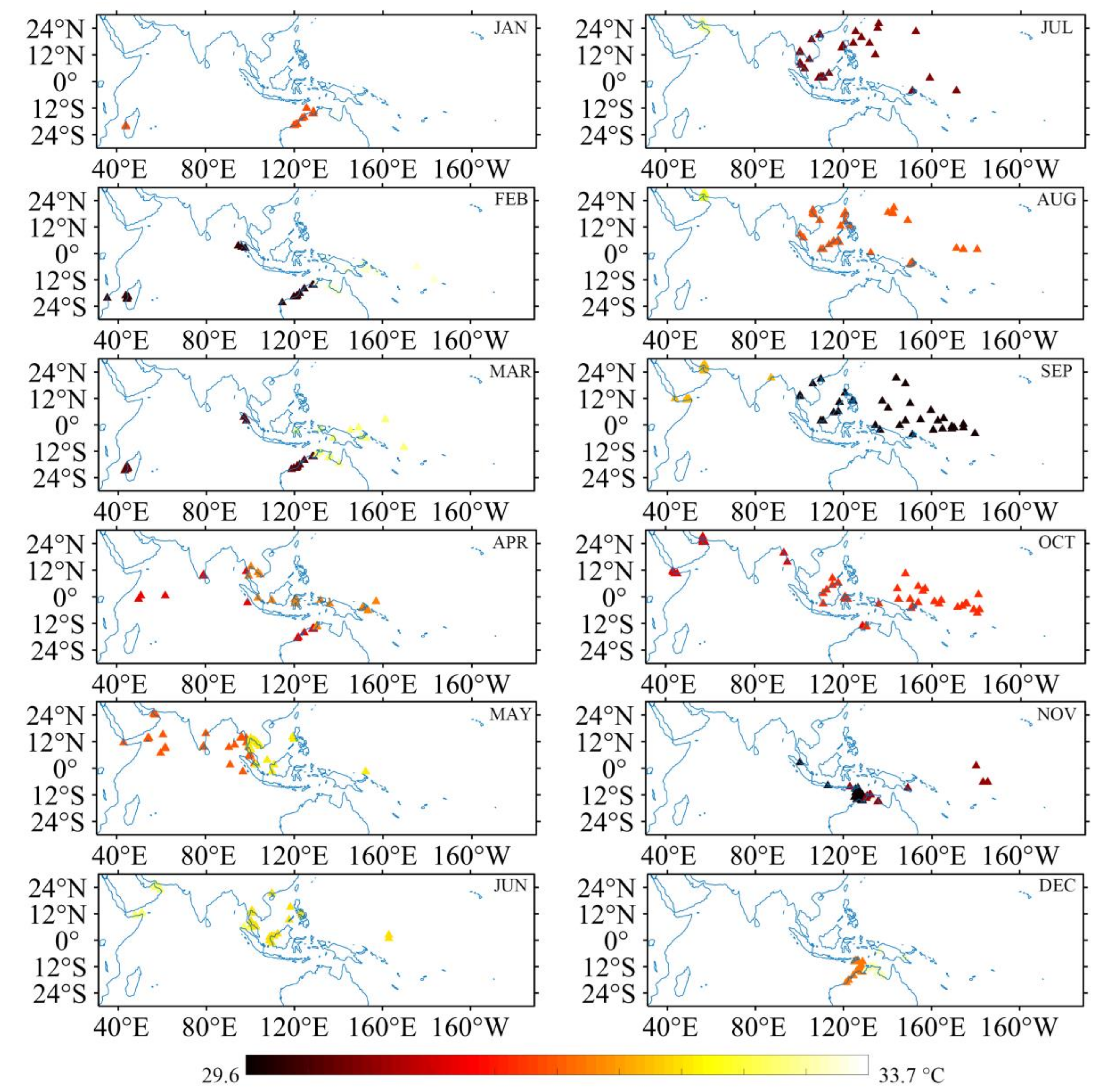
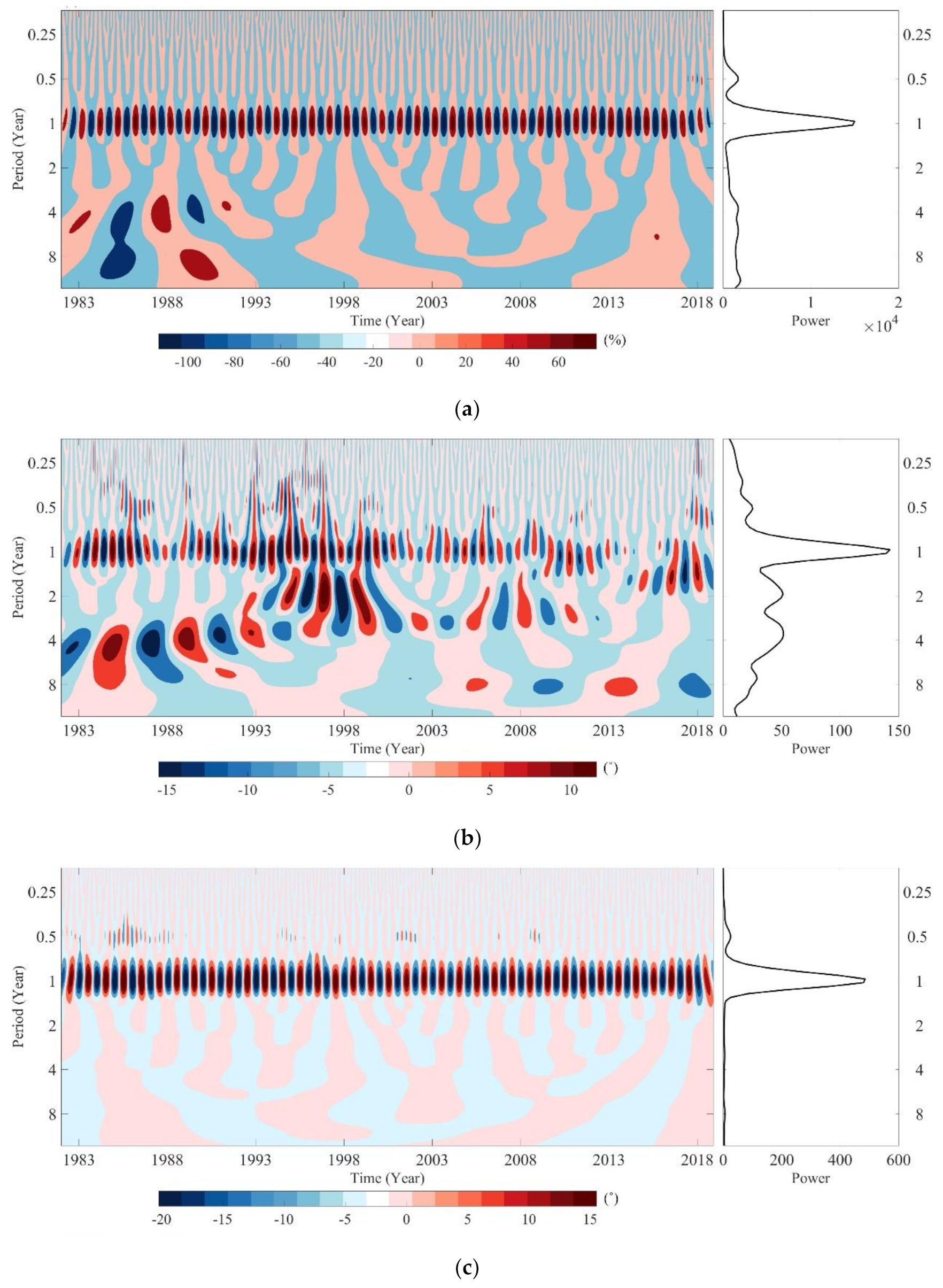
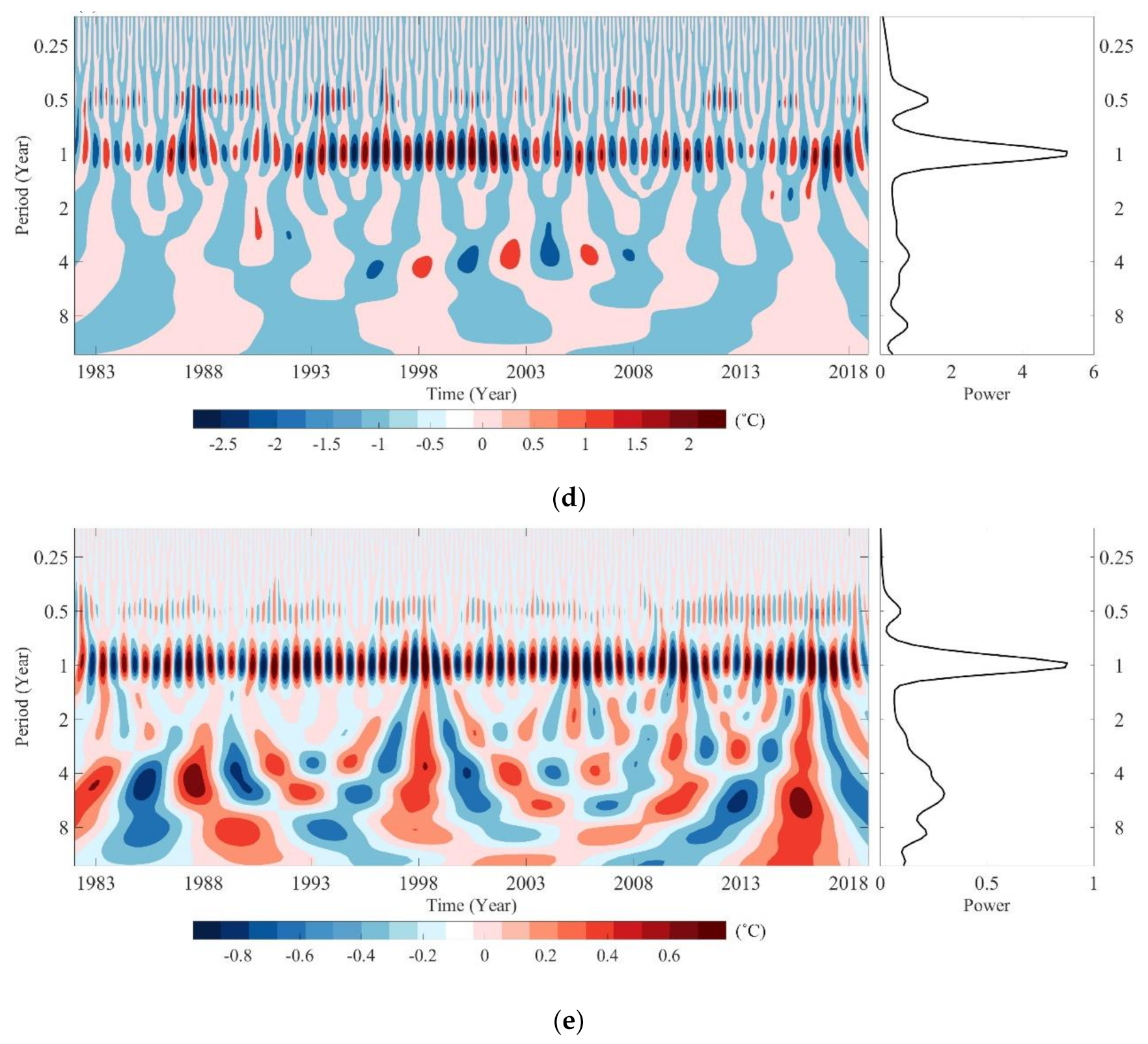
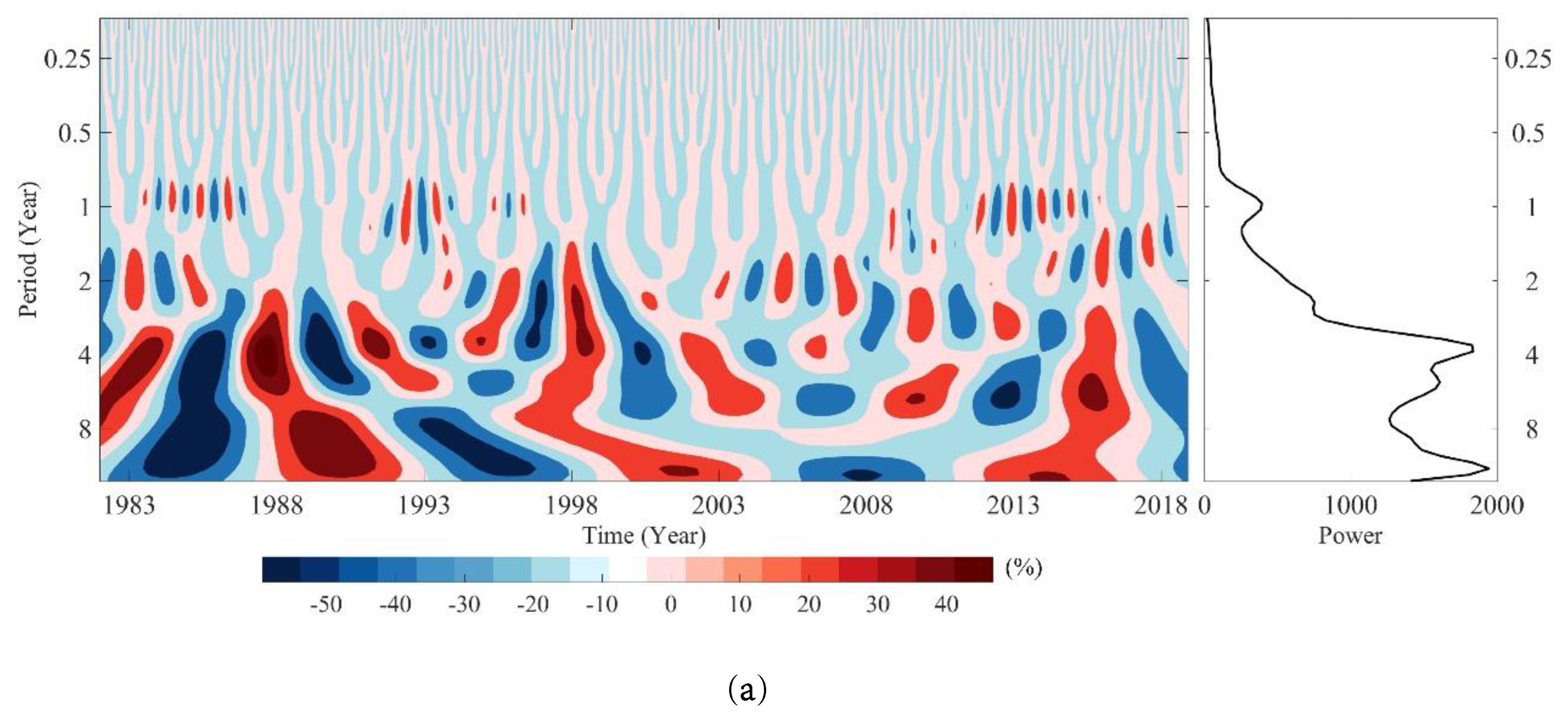
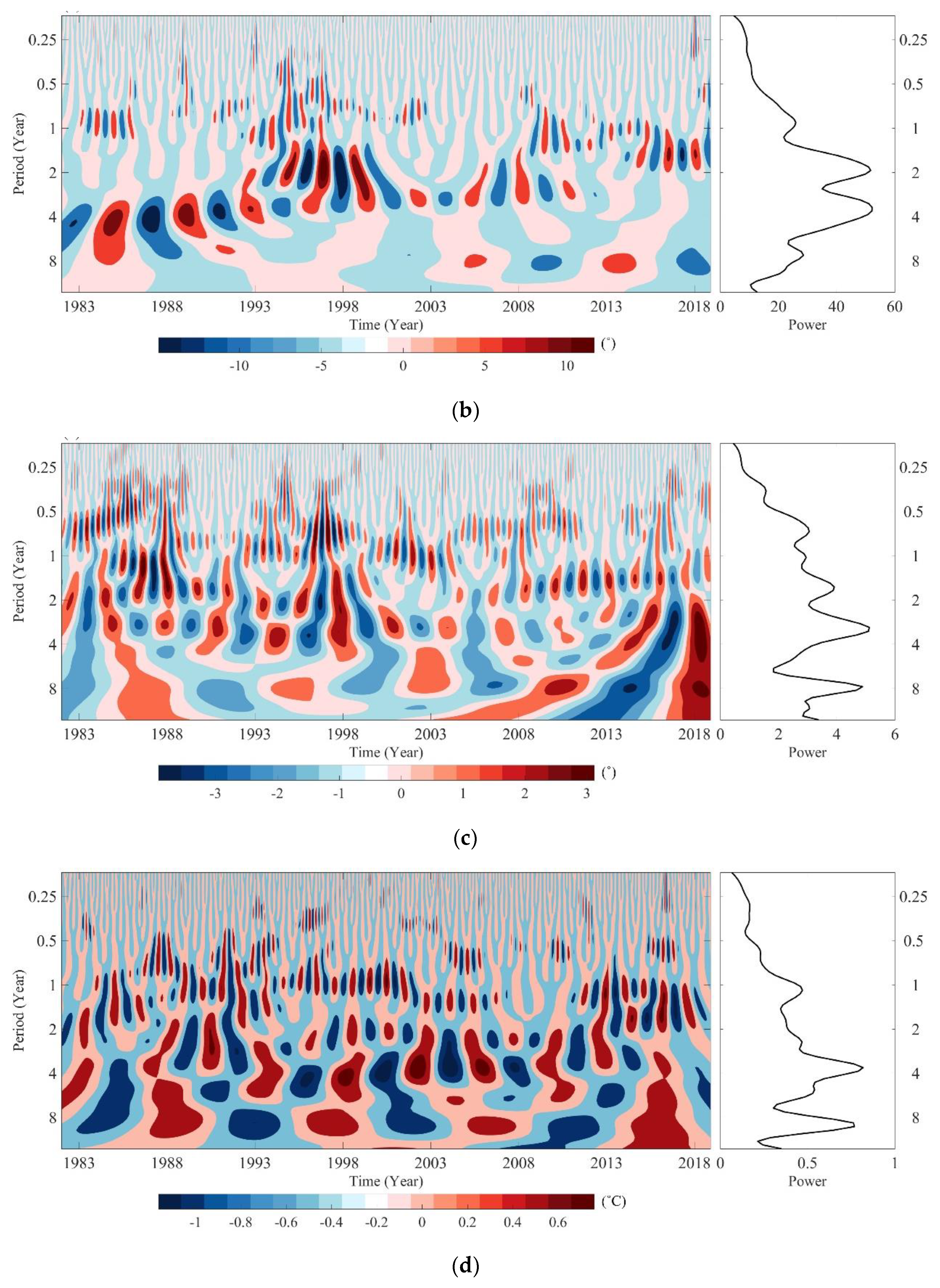
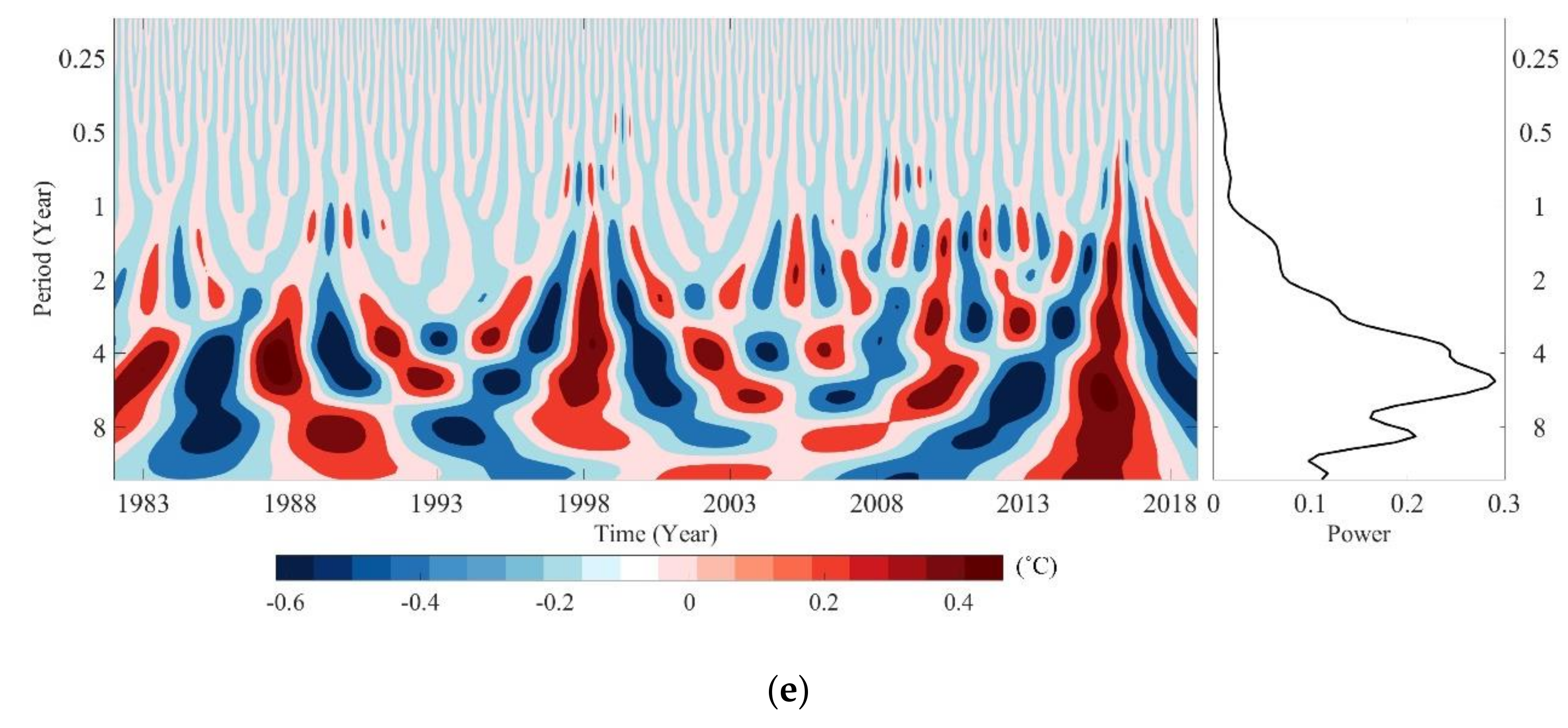
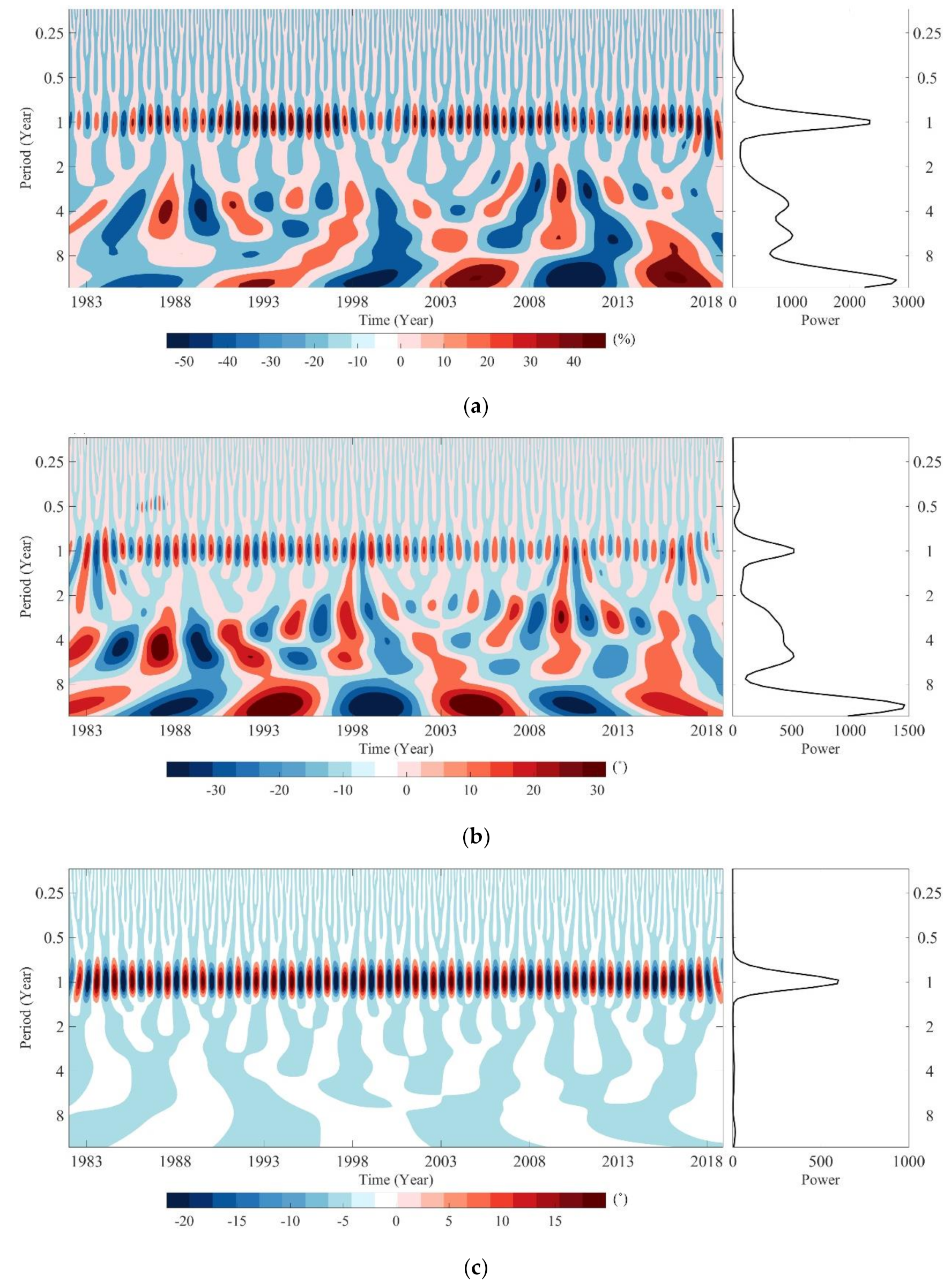
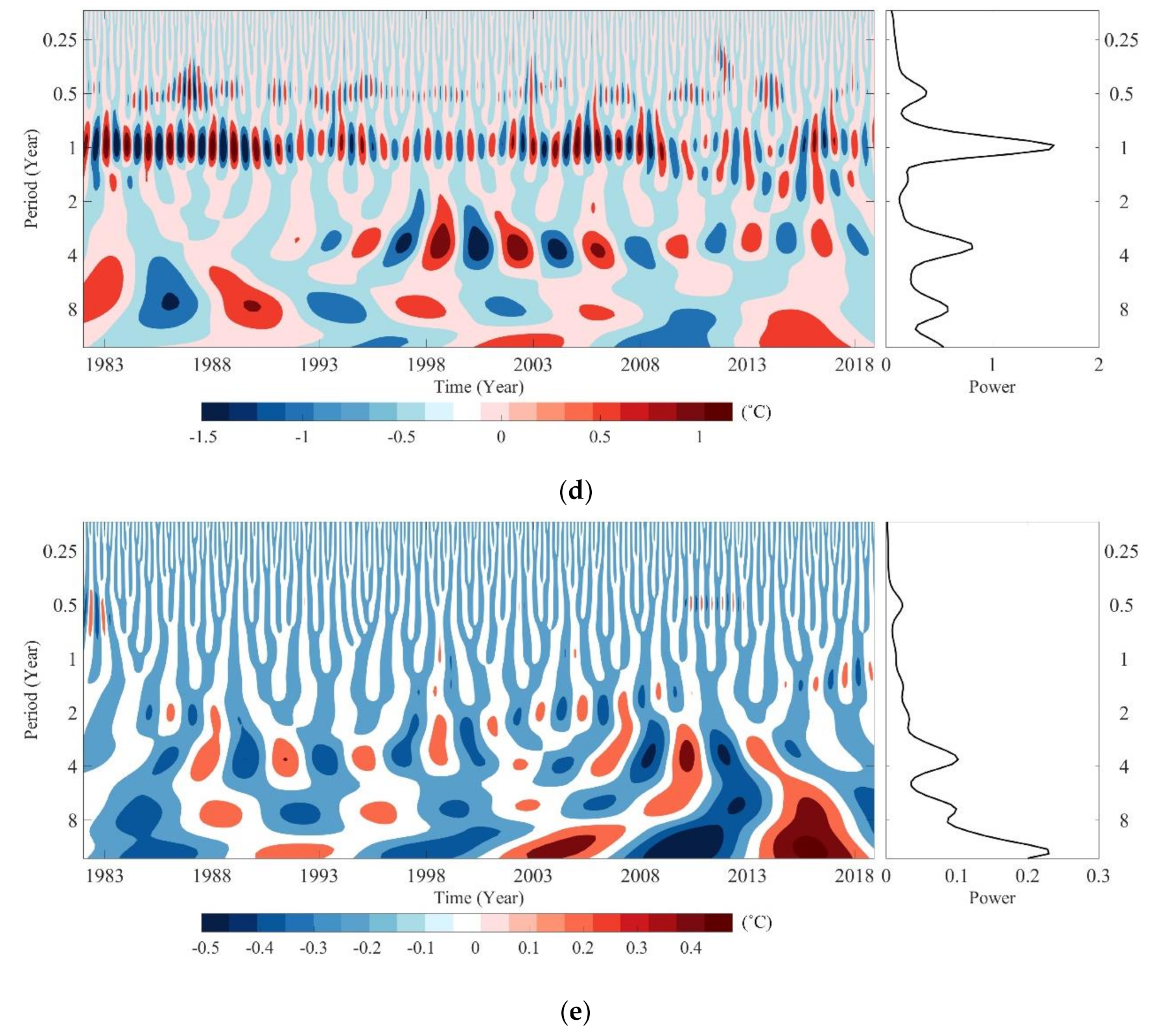
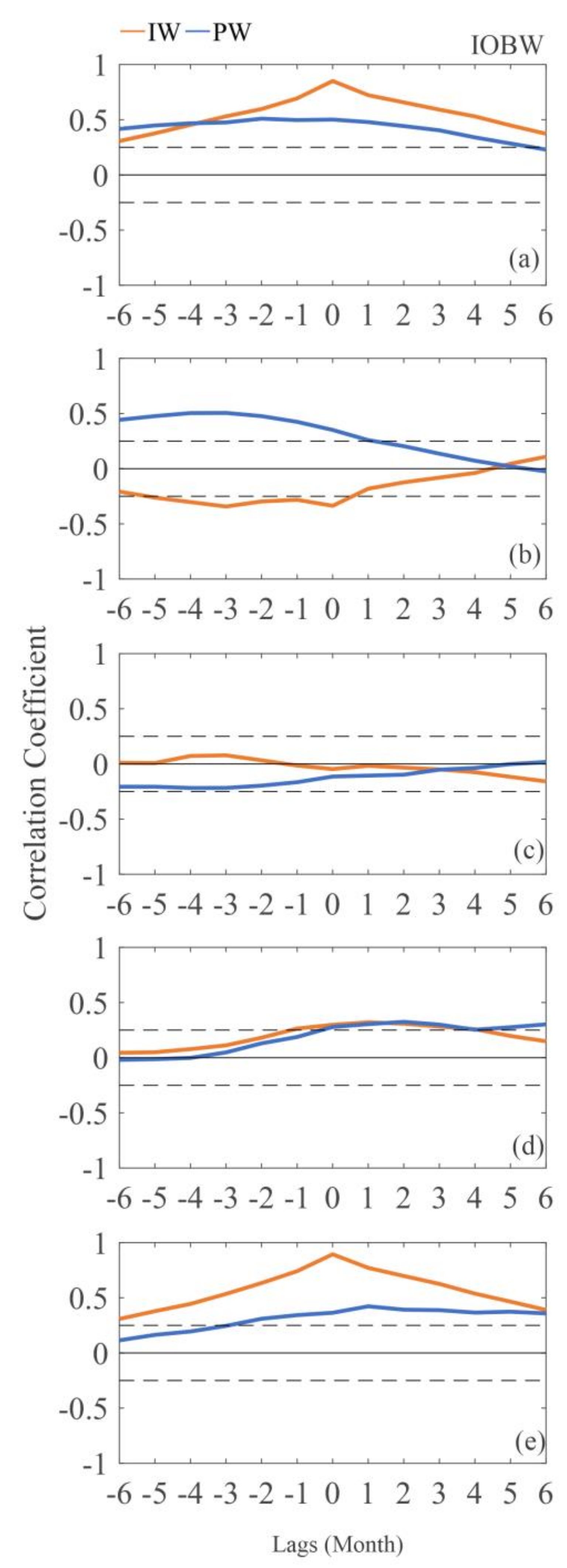
| Warm Pool Properties | Climate Indices | IW | PW | ||||||
|---|---|---|---|---|---|---|---|---|---|
| DJF | MAM | JJA | SON | DJF | MAM | JJA | SON | ||
| Size | Nino 3.4 | 0.44 | 0.57 | 0.25 | 0.27 | 0.59 | 0.62 | 0.58 | 0.63 |
| EMI | 0.07 | 0.14 | −0.31 | −0.12 | 0.28 | 0.27 | 0.25 | 0.33 | |
| IOD | 0.10 | −0.15 | 0.22 | 0.20 | −0.01 | 0.11 | 0.08 | 0.29 | |
| IOBW | 0.96 | 0.95 | 0.97 | 0.95 | 0.85 | 0.81 | 0.69 | 0.70 | |
| Zonal Movement | Nino 3.4 | −0.31 | −0.06 | −0.25 | −0.57 | 0.91 | 0.82 | 0.88 | 0.89 |
| EMI | −0.03 | −0.10 | 0.12 | −0.24 | 0.71 | 0.68 | 0.59 | 0.79 | |
| IOD | −0.54 | −0.69 | −0.86 | −0.83 | 0.13 | 0.05 | 0.22 | 0.55 | |
| IOBW | −0.63 | −0.16 | −0.39 | −0.66 | 0.30 | 0.41 | 0.30 | 0.16 | |
| Meridional Movement | Nino 3.4 | 0.46 | −0.58 | −0.13 | 0.29 | −0.32 | −0.35 | −0.42 | −0.50 |
| EMI | 0.38 | 0.03 | 0.10 | 0.16 | −0.21 | −0.39 | −0.62 | −0.65 | |
| IOD | 0.35 | 0.48 | 0.04 | 0.49 | −0.06 | −0.22 | 0.10 | −0.23 | |
| IOBW | 0.59 | −0.55 | −0.20 | −0.05 | 0.15 | −0.26 | 0.09 | 0.17 | |
| Maximum SST | Nino 3.4 | 0.33 | 0.55 | 0.08 | 0.12 | 0.17 | 0.53 | −0.10 | −0.16 |
| EMI | 0.11 | 0.17 | −0.17 | −0.33 | −0.10 | 0.08 | −0.27 | −0.37 | |
| OD | −0.31 | −0.11 | −0.01 | 0.05 | −0.17 | −0.37 | −0.29 | −0.19 | |
| IOBW | 0.61 | 0.82 | 0.27 | 0.35 | 0.13 | 0.58 | 0.42 | 0.41 | |
| Mean SST | Nino 3.4 | 0.61 | 0.67 | 0.31 | 0.37 | 0.44 | 0.46 | 0.00 | 0.13 |
| EMI | 0.19 | 0.19 | −0.31 | −0.14 | 0.25 | 0.35 | −0.09 | −0.09 | |
| IOD | 0.00 | −0.06 | 0.18 | 0.28 | −0.01 | 0.21 | −0.05 | −0.01 | |
| IOBW | 0.95 | 0.99 | 0.95 | 0.94 | 0.72 | 0.79 | 0.63 | 0.69 | |
© 2020 by the authors. Licensee MDPI, Basel, Switzerland. This article is an open access article distributed under the terms and conditions of the Creative Commons Attribution (CC BY) license (http://creativecommons.org/licenses/by/4.0/).
Share and Cite
Yin, Z.; Dong, Q.; Kong, F.; Cao, D.; Long, S. Seasonal and Interannual Variability of the Indo-Pacific Warm Pool and its Associated Climate Factors Based on Remote Sensing. Remote Sens. 2020, 12, 1062. https://doi.org/10.3390/rs12071062
Yin Z, Dong Q, Kong F, Cao D, Long S. Seasonal and Interannual Variability of the Indo-Pacific Warm Pool and its Associated Climate Factors Based on Remote Sensing. Remote Sensing. 2020; 12(7):1062. https://doi.org/10.3390/rs12071062
Chicago/Turabian StyleYin, Zi, Qing Dong, Fanping Kong, Dan Cao, and Shuang Long. 2020. "Seasonal and Interannual Variability of the Indo-Pacific Warm Pool and its Associated Climate Factors Based on Remote Sensing" Remote Sensing 12, no. 7: 1062. https://doi.org/10.3390/rs12071062
APA StyleYin, Z., Dong, Q., Kong, F., Cao, D., & Long, S. (2020). Seasonal and Interannual Variability of the Indo-Pacific Warm Pool and its Associated Climate Factors Based on Remote Sensing. Remote Sensing, 12(7), 1062. https://doi.org/10.3390/rs12071062





